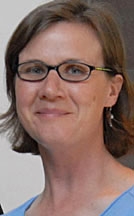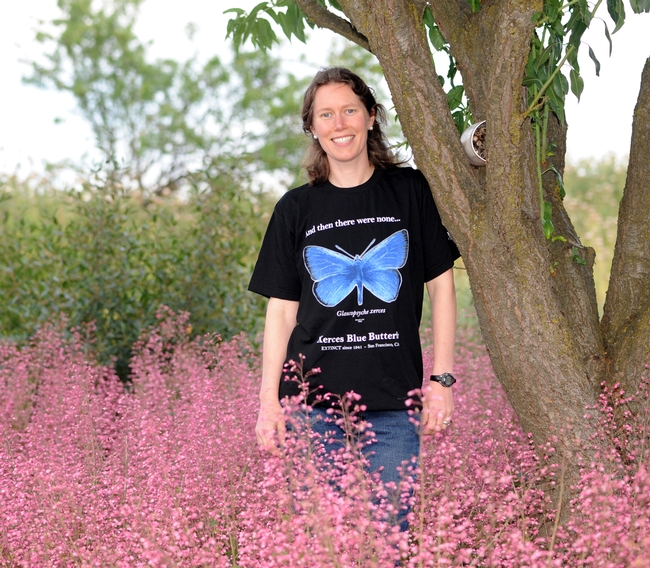
Nature has none. Zip. Zero. Zilch.
The Xerces Blue Butterfly, which once thrived on the San Francisco Peninsula before urbanization chased it away, is extinct.
There are no more. It “lives” only as specimens in several insect museums, including the Bohart Museum on the UC Davis campus.
Scientists at the Bohart Museum are spotlighting it on a t-shirt in an effort to draw attention to the fact that we need to protect our threatened and endangered species, or they, too, will become extinct like the Xerces Blue.
The t-shirt spreads the “E” word (Extinction). Lettered above the image of the dazzling blue butterfly (Glaucopsyche xerces) are the words: “And Then There Were None.”
“Some folks have asked us why we created a t-shirt featuring an extinct butterfly,” said t-shirt designer Fran Keller, a doctoral candidate in entomology based at the Bohart. “It not only makes the public aware of the fragility of insects but also shows how much research is still needed to be aware of the interactions between humans and insects and the overall impact his has on the environment.”
“The concept,” Keller said, “is that we will lose what we don’t know we have.”
Davis naturalist-photographer Greg Kareofelas made the images from specimens locked away in the Bohart Museum.
The butterfly, endemic to the San Francisco Peninsula, was first described and documented in 1852. Scientists believe it became extinct in the early 1940s due to human disturbance: loss of habitat caused by urban development.
The butterfly drew its name from the French spelling of "Xerxes," the name of Persian kings Xerxes I and Xerxes II of the fifth century BC.
Entomologist W. Harry Lange (1912-2004) unknowingly collected what is now considered the last known specimen. Lange, who donated some 1 million insect specimens to the museum during his entomological career, collected it at the Presidio military base on March 23, 1941. He later reportedly lamented “I always thought there would be more. I was wrong.”
Only a few U.S. museums, including the Bohart Museum, California Academy of Sciences and the Harvard Museum of Natural History, have specimens of the Xerces Blue (family Lycaenidae), Keller said.
The Bohart Museum, home of more than seven million insect specimens, houses the seventh largest insect collection in North America and is dedicated to teaching, research and service. Founded in 1946 by UC Davis entomologist Richard M. Bohart and now directed by Lynn Kimsey, UC Davis professor of entomology, the museum aims to educate the public about insect diversity, conservation and preservation as part of its mission.
The T-shirt is available online and at the Bohart Museum, 1124 Academic Surge, California Drive, UC Davis campus.
Attached Images:

Tabatha Yang, outreach and education coordinator at the Bohart Museum, wearing a Xerces Blue Butterfly shirt. (Photo by Kathy Keatley Garvey)